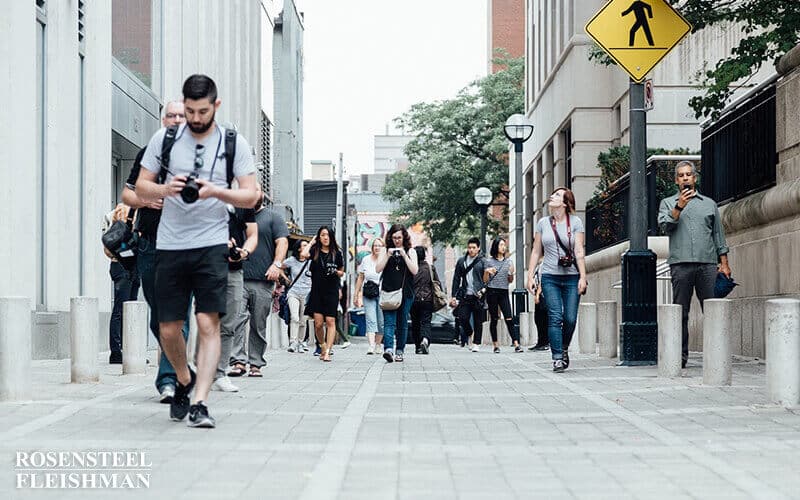After a crash, it is completely normal to feel overwhelmed. Many people are unsure about what to do next, especially when insurance companies begin asking questions that feel rushed or confusing. The process can feel even more stressful when you are dealing with pain, vehicle damage, or worry about missing work. Having the right support […]

What laws Protect Pedestrians From Car Accidents
With the warm summer months approaching, Charlotte’s sunny summer landscape beckons locals and visitors to get out and explore. From festivals to 5k marathons, the Queen City creates a family-friendly atmosphere that encourages people to get out the house and walk the streets. With this comes the increased risks of motor vehicle-pedestrian accidents.
According to the National Highway Traffic Safety Administration, in 2017, there were 5,977 pedestrians killed in traffic crashes, a 1.7% decrease from the 6,080 pedestrian fatalities in 2016. Of that number, nearly one-fifth (19%) of the fatalities were children 14 years of age and younger. Further, twenty-six percent (26%) of pedestrian fatalities occurred from 6 to 9 p.m. in 2017. And sadly, one (1) of every five (5) pedestrians killed were struck in crashes that involved hit-and-run drivers. Not to mention, forty-seven percent (47%) of fatal pedestrian crashes in 2017 involved alcohol—for the driver and/or the pedestrian. For purposes of these statistics, a pedestrian is any person on foot, walking, running, jogging, hiking, sitting, or lying down who is involved in a motor vehicle traffic crash (excluding people on personal conveyances like roller skates, skateboards, scooters, or Segway-style devises).
In North Carolina, the rights of a pedestrian and motorists on a public road are mutual, reciprocal, and equal. Neither may use the public way in disregard of the right of the other, and each must accommodate his or her movements to the other’s lawful use. In addition, both pedestrian and motorists must anticipate the other’s possible presence and must recognize the dangers inherent in the manner in which the public way may be lawfully used by the other. However, because motor vehicles pose a relatively greater hazard to pedestrians, motorists are often charged with a duty of special care to pedestrians. Nevertheless, the conduct of both a motorists and a pedestrian must be considered when assessing fault in a motor vehicle-pedestrian collision case.
By and large, pedestrians have the right of way at all intersections and driveways. However, N.C.G.S. §20-174 provides that every pedestrian crossing a roadway where there is no marked crosswalk shall yield the right-of-way to all vehicles upon the roadway. In addition, where sidewalks are provided, it is unlawful for any pedestrian to walk along and upon an adjacent roadway. Where sidewalks are NOT provided, any pedestrian walking along and upon a highway shall, when practicable, walk on the left shoulder facing traffic. Notwithstanding these provisions, a motorist is obliged to exercise due care to avoid colliding with any pedestrian, and shall undertake proper precaution upon observing any child or any confused or incapacitated person upon a roadway. N.C.G.S. §20-174(e).
Lawsuits arising out of motor vehicle-pedestrian accidents often involve allegations that the pedestrian’s own negligence in some way contributed to his or her injury. This is of particular importance in North Carolina because of the doctrine of contributory negligence. Under this doctrine, if the pedestrian is even one percent responsible for the accident, he or she may be prevented from recovering compensation. In other words, failing to obey traffic control signals, such as WALK/DON’T WALK indicators at crosswalks may be evidence of pedestrian negligence. This may be troublesome for the frequent joggers who are often distracted by their music and fail to pay attention at crosswalks. Or more commonly, pedestrians who have drunk too much alcohol and negligently or recklessly enter the streets in oncoming traffic. In the latter, voluntary intoxication will not relieve one from contributory negligence. In general, the actions of persons who are voluntarily intoxicated will be evaluated by the same standard as a sober person’s actions. The fact that an individual may have been impaired due to the use of alcohol or other intoxicating substances does not lessen the person’s burden of care for his or her own safety.
On the contrary, there are many instances when the pedestrian is acting with reasonable care and the motorist disregards traffic laws, especially laws that apply to school zones and school buses. In North Carolina, motorists must stop for and cannot pass a stopped school bus; they must obey school crossing guards when they stop traffic so students can cross the street; motorists must comply with all reduced speed limits and slow down for blinking lights in school zones; and motorists must yield to pedestrians at all turns and at all crosswalks in school zones. In cases dealing with children, depending on the child’s age, contributory negligence may not bar recovery of compensation for the child and his or her family. Taking legal action in these situations not only compensates the child and family, but also sends a strong message to the community about the importance of traffic safety in school zones and near school buses.
In other occasions, drivers are held responsible for motor vehicle-pedestrian accidents for speeding and not being able to stop or slow down to avoid a collision. Furthermore, motorists could be driving while drowsy and inattentive to his or her surroundings causing danger to himself and other pedestrians that may be walking along the roadways. More commonly, however, drivers are simply impaired by alcohol or other intoxicating substances which interfere with their ability to drive safely. There may also be cases when the driver may simply believe he or she have the right of way and recklessly continue through a crosswalk—indifferent to the potential danger of striking a pedestrian. Though, in more recent matters, drivers are distracted by cell phone use, which includes phone calls, text messages, or utilizing social media applications and fail to yield at crosswalks or other intersections. In either case, police reports, eyewitness accounts, red light cameras or security cameras, and cell phone records can all be used to help establish the driver’s fault.
At Rosensteel Fleishman Car Accident & Injury Lawyers we encourage both motorists and pedestrians to review North Carolina’s traffic laws. If you or loved one have been injured in a motor vehicle-pedestrian accident, contact the dedicated attorneys at Rosensteel Fleishman Car Accident & Injury Lawyers, you may be entitled to compensation for medical expenses, lost income, pain and suffering and other losses.
Additional Car Accident Personal Injury Articles
When someone suffers a leg injury at work, the experience can leave them feeling overwhelmed, uncertain, or even frustrated. Everyday tasks become difficult, and the reality of missed work, medical appointments, and financial concerns can quickly add stress to an already complicated situation. Many people are unsure about what rights they have or how to […]
When a serious accident happens, everything can feel uncertain. The physical pain is only part of the struggle because the emotional and financial pressure can grow quickly. People often try to handle things on their own at first, but when injuries are life threatening, the stakes are too high to guess your way through the […]
When a broken arm happens because of an accident, the stress that follows can feel overwhelming. The pain, medical appointments, and disruption to daily life often leave people unsure about what to do next. It can be especially confusing when the injury was caused by someone else’s carelessness. Many people in this situation want clear […]
